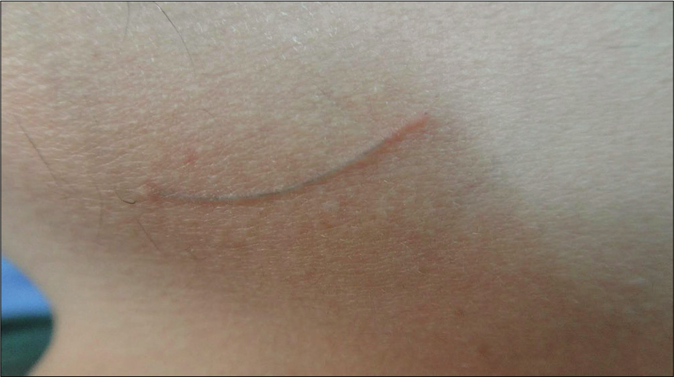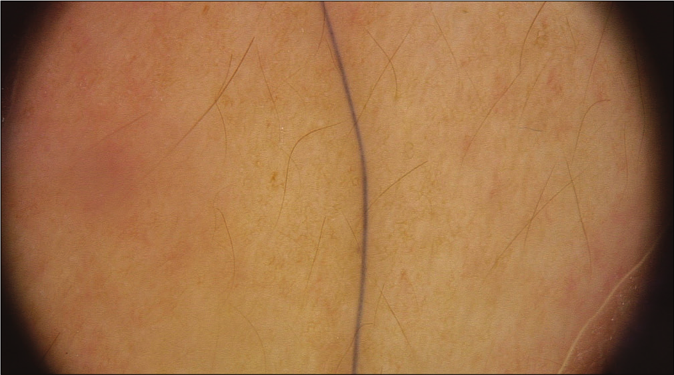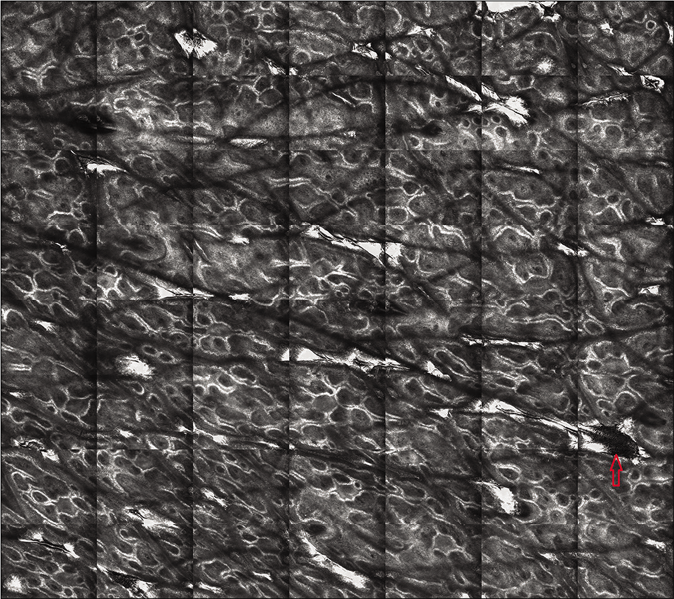Translate this page into:
Cutaneous pili migrans: A case confirmed by dermoscopy and reflectance confocal microscopy
Corresponding author: Dr. Zhi-Yuan Yao, Department of Dermatology and Venereology, China-Japan Friendship Hospital, Beijing 100029, China. zryhyao@126.com
-
Received: ,
Accepted: ,
How to cite this article: Liu X, Yao ZY. Cutaneous pili migrans: A case confirmed by dermoscopy and reflectance confocal microscopy. Indian J Dermatol Venereol Leprol 2021;87:244-6.
Sir,
Cutaneous pili migrans is a rare disease; not more than 30 cases (including seven ingrowing hair cases) have been reported so far. “Ingrowing hair” refers to the hair with follicles growing into the skin, rather than hair shafts moving alone, which is seen even more rarely.1 A total of seven cases, including four Japanese and three Chinese ones1,3 have been reported till now. In this study, we report another case which, to the best of our knowledge, was the first reported case describing the dermoscopic and reflectance confocal microscopic characteristics of this condition.
A 35-year-old Chinese man discovered a black line beneath the skin of the left jaw 4 days prior to presentation. He did not feel any discomfort and he denied any history of trauma or acne on chin or self-induction (plucking or extruding the beard hairs). There was no similar history among his family members. Physical examination revealed a 4 cm long, thick, black hair shaft embedded in the epidermis on the left jaw with an inflammatory response at the end of the lesion [Figure 1a]. Dermoscopy showed thick black hair under the skin without vasodilation [Figure 1b]. Reflectance confocal microscopy revealed the growth of low-refractive hair with intact follicle [Figures 2 and 3]. Later, the thin skin above the black line was pricked by a sterile syringe, to remove the black line [Figure 4]. The exposed hair shaft was clamped to pull out the entire hair. The process of removing hair was difficult due to the firmly stuck hair.

- The image shows a 4-cm-long thick, black hair shaft embedded in the epidermis on the left jaw with inflammation discovered at the end of the lesions

- The image shows thick black hair under the skin without vasodilation (×20, polarized light)

- The image shows the low-refractive hair in the skin

- The image shows the presence of follicle (the red arrow)

- The black thread is the hair shaft
Cutaneous pili migrans has been described by other authors with synonyms such as embedded hair, bristle migrans, burrowing hair, moving hair, creeping hair and ingrowing hair.4 Some scholars hold the view that “ingrowing hair” can be used specifically to refer to one type of cutaneous pili migrans. It can be categorized into two classes based on etiology and the presence of hair follicles. One is the exogenous hair embedded in the skin which involves only hair shaft and occurs when external forces are applied. The other is “ingrowing hair”, which has intact follicle and grows into the skin, but exact mechanisms are unknown. Though the exact mechanisms for ingrowing hair remain unknown, factors that can cause change to the direction of hair growth are potential pathogenic factors such as folliculitis, perifolliculitis or hair follicle edema caused by friction, pulling or extruding beard hair. The force making the hair move is considered to be seŁ body motion.5 At present, seven cases of “ingrowing hair” have been reported, all of which were observed in young and middle-aged men [Table 1].3,4 Thickness and hardness of hair can be considered as the necessary requirements for the disease.
| Year | Sex/age | Duration | Location | Material | Length of eruption (cm) | Length of hair (cm) | Country | Reference |
|---|---|---|---|---|---|---|---|---|
| 1990 | Man/42 | NF | Right cheek | Hair | 6 | 4.5 | Japan | 2 |
| 1994 | Man/34 | NF | Neck | Hair | 2.5 | 2.5 | Japan | 2 |
| 1997 | Man/58 | NF | Right frontal neck | Hair | 5 | 5 | Japan | 2 |
| 2003 | Man/52 | NF | Right frontal neck | Hair | 3 | 3 | Japan | 2 |
| 2016 | Man/30 | 1 year | Right chin | Hair | 4.3 | 4.3 | China | 1 |
| 2018 | Man/26 | 1 month | Right mandibular angle | Hair | 4.3 | 4 | China | 3 |
| 2018 | Man/31 | 3 month | Right neck near the jaw | Hair | 8 | 8 | China | 3 |
NF: not found (due to unavailability of similar Japanese journals)
Cutaneous pili migrans is a black colored, thread-like eruption that migrates in a linear direction. It is consistently asymptomatic. The ultimate treatment is hair removal. To prevent such diseases, pulling or extruding beard hair should be avoided in daily life. Timely treatment of folliculitis and perifolliculitis is also very important.
The reason to report this case is not only because cutaneous pili migrans is a rare disease but also because the hair located beneath the skin is easily visible with the assistance of dermoscopy and reflectance confocal microscopy which could help to reveal the structure of the hair follicles. Moreover, it is easy to identify the creeping eruption to make an accurate diagnosis. Furthermore, we were unable to find any previous reports of cutaneous pili migrans with dermoscopy and reflectance confocal microscopy features described alongwith.
Declaration of patient consent
The authors certify that they have obtained all appropriate patient consent.
Financial support and sponsorship
Nil.
Conflicts of interest
There are no conflicts of interest.
References
- Ingrowing hair: A case report. Medicine (Baltimore). 2016;95:e3660.
- [CrossRef] [PubMed] [Google Scholar]
- Creeping hair: an isolated hair burrowing in the uppermost dermis resembling larva migrans. Dermatology. 2006;213:242-4.
- [CrossRef] [PubMed] [Google Scholar]
- Intradermal growing hair: Two case reports. Am J Mens Health. 2019;13:1557988319825774.
- [CrossRef] [PubMed] [Google Scholar]
- Cutaneous pili migrans: A creeping eruption like condition easy to diagnose and cure. Med J Armed Forces India. 2016;72:97-8.
- [CrossRef] [PubMed] [Google Scholar]
- Cutaneous pili migrans: A case report and review of the literature. Int J Dermatol. 2009;48:947-50.
- [CrossRef] [PubMed] [Google Scholar]





